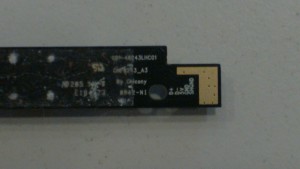RepRap extruders
The other day came across this amazing video of a new technique called Mataerial (http://www.mataerial.com/#mataerial-in-action). The system in itself is not at all RepRap oriented, but as 3D printing technique is quite impressive.
The reason why it is mentioned here, other than its awesomeness, is that it actually inspired the topic of this post: looking at its extrusion system and how it is related to the printing material, makes you realize how intrinsically connected is the material to the extruding technique. So here it comes our next enumeration of important parameters defining 3D printer parts: extruders.
So far, RepRap extruder technologies consist mainly of two well differentiated parts: the hot end and the cold end.
The hot end is where the thermoplastic is actually molten before being deposited to construct the printed object. It is generally composed of a nozzle of brass or another highly conductive material attached to a resistor that provides the heat and to a channel for conducting the filament. A thermistor or thermocouple is also necessary to give feedback to the printer processor in order to maintain a constant fusion temperature.
The filament tractor or cold end is the part of the extruder in charge of pushing the plastic into the hot end. For such purpose it uses a stepper motor and some gearing of different level of sophistication. This is generally the most bulky part, and adds some amount of mass (and hence inertia) to the final extruder. For this reason, Bowden extruders keep the cold end separated and fixed to the structure of the printer, which allows for faster movement with less shaking. Unfortunately, Bowden extruders are better but still not perfect, so the filament gets compressed into the tube making the control of the pressure in the hot end a difficult task.

Bowden type extruder: the hot end and the traction for the filament are separated (source: start3dprinting.com)

Direct extruder: the filament is pushed directly into the hot end (source: reprap wiki)
In RepRap’s wiki there are some references (http://reprap.org/wiki/Category:Extruders), but in general the quality of the information is way poorer than on the rest of the RepRap elements. The reason for this might be that the extruder technology is still under much development, as it is a very delicate part that many people can fiddle with but few dare to share.
From RepRap’s embryo of comparison table for hot ends (http://reprap.org/wiki/Hotend_Comparison), we however can extract some interesting general parameters:
- Extrusion material: The range of materials that can be used comes determined by the operational temperature. So, ABS (215-250 C), PLA (180-220 C), and Nylon (190-350 C) are the plastics most commonly used.
- Input diameter: This is the filament’s diameter that the extruder tolerates. There are two common diameters of 3D Printer plastic filament, 1.75mm and 3mm. Each printer (or to be more specific, each extruder) is designed to work with one diameter of plastic filament and will not work with the other.
- Output diameter: This value ranges between 0.3 mm (very thin) and 1.0 mm (very thick). The correct value is a tradeoff between long printing times, degree of detail, “delicacy” of the printing process and speed, roughness and reliability. In this matter the quality of the plastic plays a very important role.
- Temperature of first layer: If the first layer of the printed object doesn’t have good adherence to the base, printing problems arise. As the base is generally colder, this initial temperature needs some calibration. Another problem is when the adherence is too high, hence breaking the piece in the moment of retiring.
- Temperature of subsequent layers: This is the actual operational temperature and must also be carefully calibrated to avoid jamming the nozzle. Also there is possibility of warp arising when the printing is too fast for the selected temperature, accumulating heat in the piece that evetually melts.
- Time to get to operative temperature (220 C deg): it should not take longer than 3 minutes to reach with a standard 6.8 ohm resistor, drawing about 1.8 Amps / 20 Watts at 12 V.
- Wattage at 220 C deg: This is a measure of the power consumption, reflected in the monthly bill, of course.
- Ooze and required retraction: Many extruders will emit (ooze) plastic even when the extruder motor is not turning. To overcome this the slicing software needs to ‘retract’ the print medium during head movement when not printing. The retraction creates negative pressure within the hot end heating chamber which effectively sucks the print medium back up through the nozzle, stopping it from oozing.
So, with this in consideration, we can start looking at different models of hotends from RepRap’s hot end category (http://reprap.org/wiki/Category:Hot_End) under a different perspective.
The task, however, is huge as the topic itself is a labyrinth of compatibilities, superseded designs and included or excluded pieces. Also, the available information in the forums is still scarce, so we could only conclude that those hotends that rely on plastics into their designs are not very reliable and prone to fail.
This seems like a sure mission for a future post!



